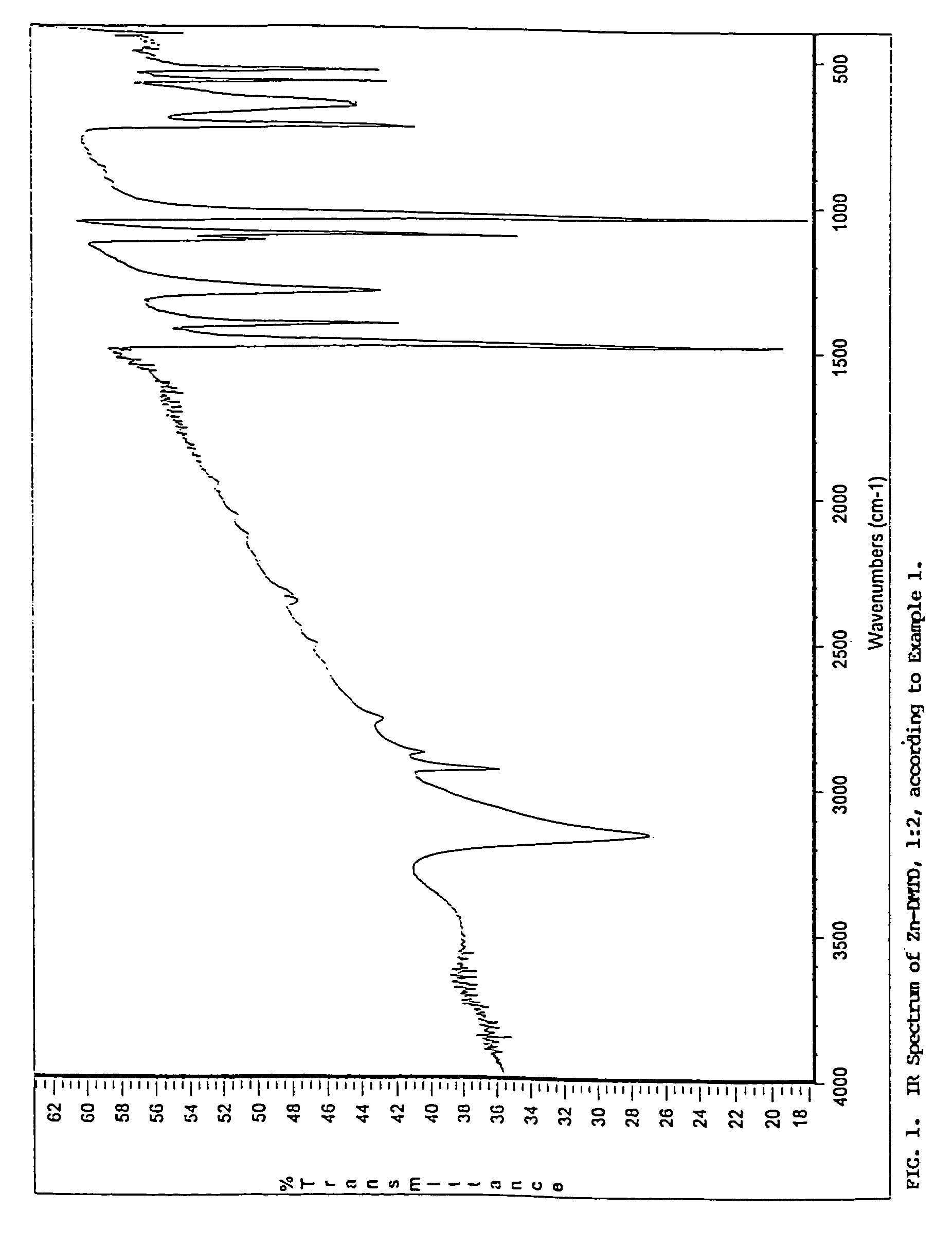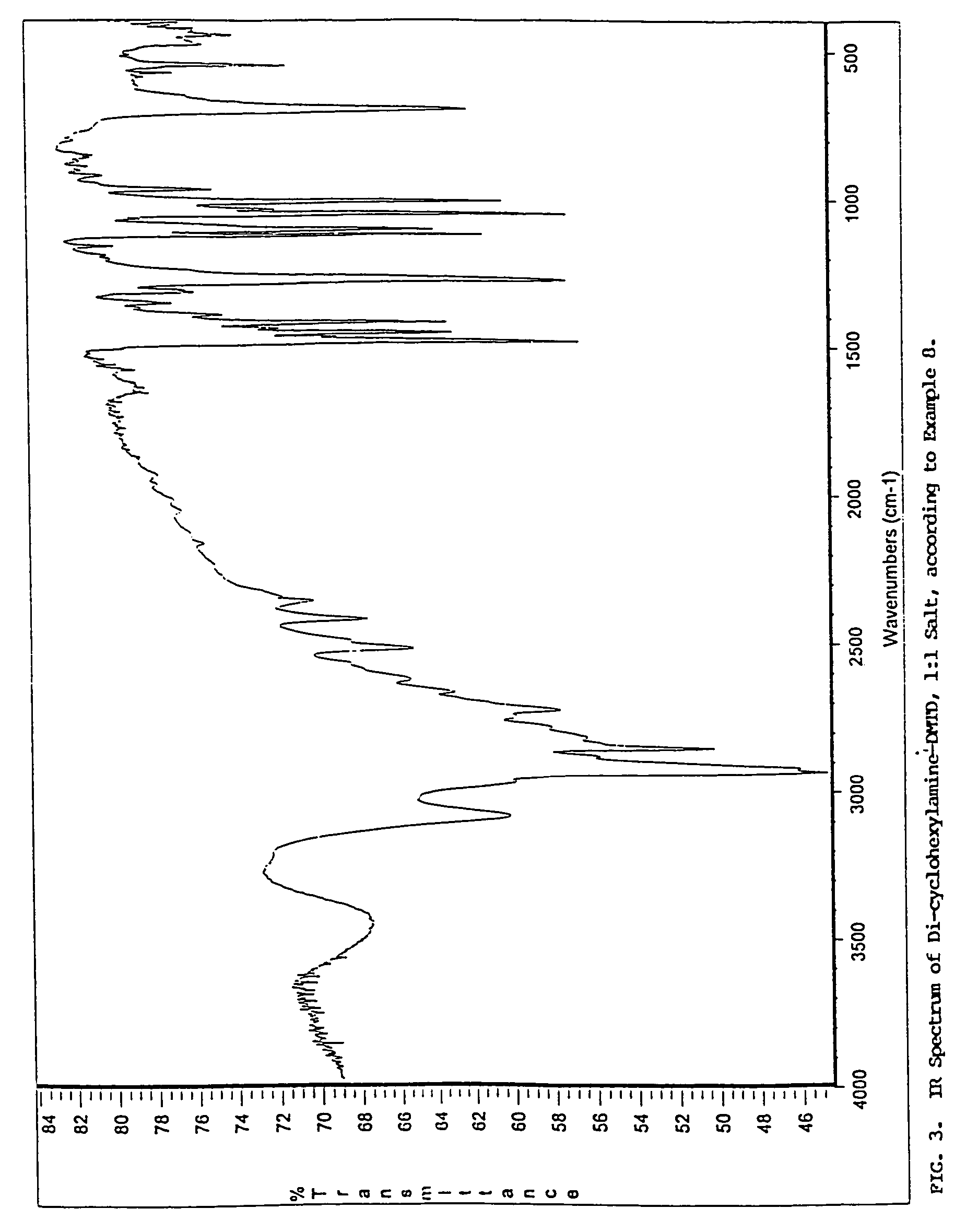Corrosion inhibitor composition applicable for aluminum and steel protection and procedure
a corrosion inhibitor and composition technology, applied in the direction of transportation and packaging, other chemical processes, solid-state diffusion coating, etc., can solve the problems of cathodic reaction of atmospheric corrosion, aluminum protection against atmospheric corrosion constitutes a significant economic challenge, and 2024 t-3 is also more susceptible to atmospheric corrosion, so as to inhibit cathodic o2 reduction, inhibit atmospheric corrosion, and reduce the effect of corrosion
- Summary
- Abstract
- Description
- Claims
- Application Information
AI Technical Summary
Benefits of technology
Problems solved by technology
Method used
Image
Examples
example 1
[0052]This example is intended to disclose the synthesis of Zn(DMTD)2 according to the above-presented Reaction 1.
[0053]As known, DMTD forms two distinct Zn(II) salts; that is, Zn-DMTD or the 1:1 salts, and Zn(DMTD)2 or the 1:2 salts. Each compound can be conveniently prepared by double decomposition in an aqueous medium, using, in corresponding stoichiometrical ratio, soluble Zn(II) salts and soluble salts of DMTD, such as Na2-DMTD and Na-DMTD, respectively. Intuitively, both salts are also expected to form by reacting ZnO and DMTD, in a 1:1 or 1:2 stoichiometrical ratio, respectively.
[0054]It has been discovered pursuant to the present invention, however, that by reacting ZnO and DMTD, only Zn(DMTD)2 forms. It will be apparent, that Reaction 1 is convenient in that it does not yield by-products. In practice, the synthesis according to reaction 1 was carried out as follows:
[0055]1 mol (81.4 g) of high grade ZnO, of 0.25 micron average particle size, was re-slurried in 300 ml water ...
example 2
[0059]This example is intended to disclose one synthesis procedure applicable for incorporating DMTD into a complex solid matrix corresponding to the general composition of 45% Zn(DMTD)2 / 32% Zn3(PO4)22H2O / 23% ZnO.
[0060]In practice, the synthesis was carried out as follows:
[0061]6.33 moles (515.0 g) of high grade ZnO (0.25 micron average particle size), was re-slurried in 2000 ml water at 50-60° C. and intense agitation for 1 (one) hour. After that, 1.5 moles of H3PO4, as 50% solution, were introduced gradually into the ZnO slurry and the same conditions were continued for 30 minutes. Subsequently, an aqueous suspension of 2.5 moles of DMTD in 1500 ml water was introduced in about 30 minutes. The intensively stirred slurry was heated to 75-80° C. and the same conditions were maintained for 2 (two) hours. The solid phase was isolated by filtration, dried at 100-105° C. to 0.5-2% moisture content and pulverized.
[0062]Relevant analytical data are presented below, in Table 2.
[0063]
TABLE ...
example 3
[0064]Application of a DMTD derivative as a corrosion inhibitor pigment:
[0065]A pigment grade composite of 45% Zn(DMTD)2 / 32% Zn3(PO4)2.2H2O / 23% ZnO, synthesized according to Example 2, was tested on aluminum, comparatively to a double control: commercial strontium chromate (Control A), which is the “gold” standard of the industry for corrosion inhibitor pigments and a molybdate-based product (Control B) considered representative of commercially available non-chromate corrosion inhibitor pigments. The test was performed in a typical two component aircraft primer formulation, specifically recommended for aluminum protection.
[0066]The description of the different versions of this formulation, the Test primer and of the Control A and Control B primers, are presented below.
[0067]
TABLE 3Trade Names &Parts by WeightComponents ofSuppliers ofControlFormulationsComponentsTestABEPOXY BASE / PART AEpoxy ResinShell Epon 1001163.0163.0163.0CX75 (1)SolventsGlycol ether PM148.0148.0148.0MIBK36.736.73...
PUM
| Property | Measurement | Unit |
|---|---|---|
| thickness | aaaaa | aaaaa |
| thickness | aaaaa | aaaaa |
| particle size | aaaaa | aaaaa |
Abstract
Description
Claims
Application Information
 Login to View More
Login to View More - R&D
- Intellectual Property
- Life Sciences
- Materials
- Tech Scout
- Unparalleled Data Quality
- Higher Quality Content
- 60% Fewer Hallucinations
Browse by: Latest US Patents, China's latest patents, Technical Efficacy Thesaurus, Application Domain, Technology Topic, Popular Technical Reports.
© 2025 PatSnap. All rights reserved.Legal|Privacy policy|Modern Slavery Act Transparency Statement|Sitemap|About US| Contact US: help@patsnap.com



